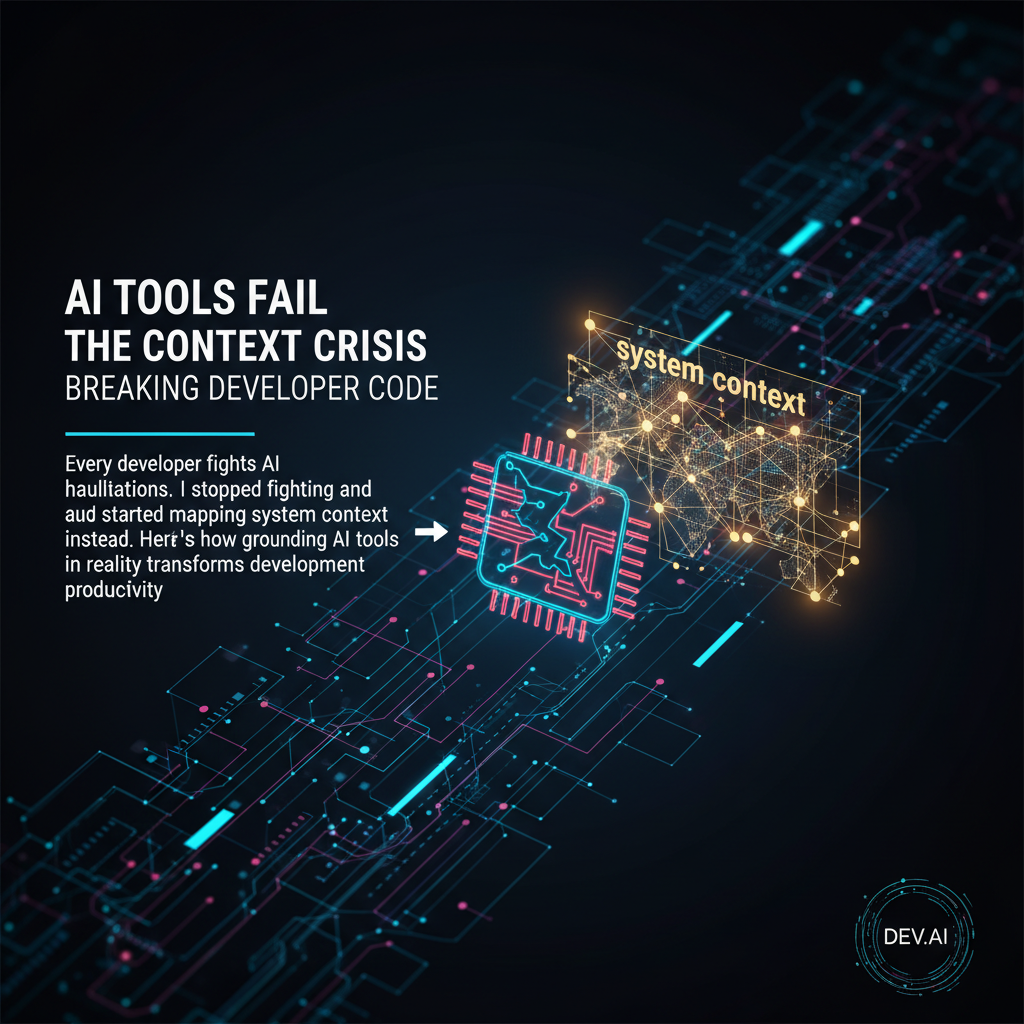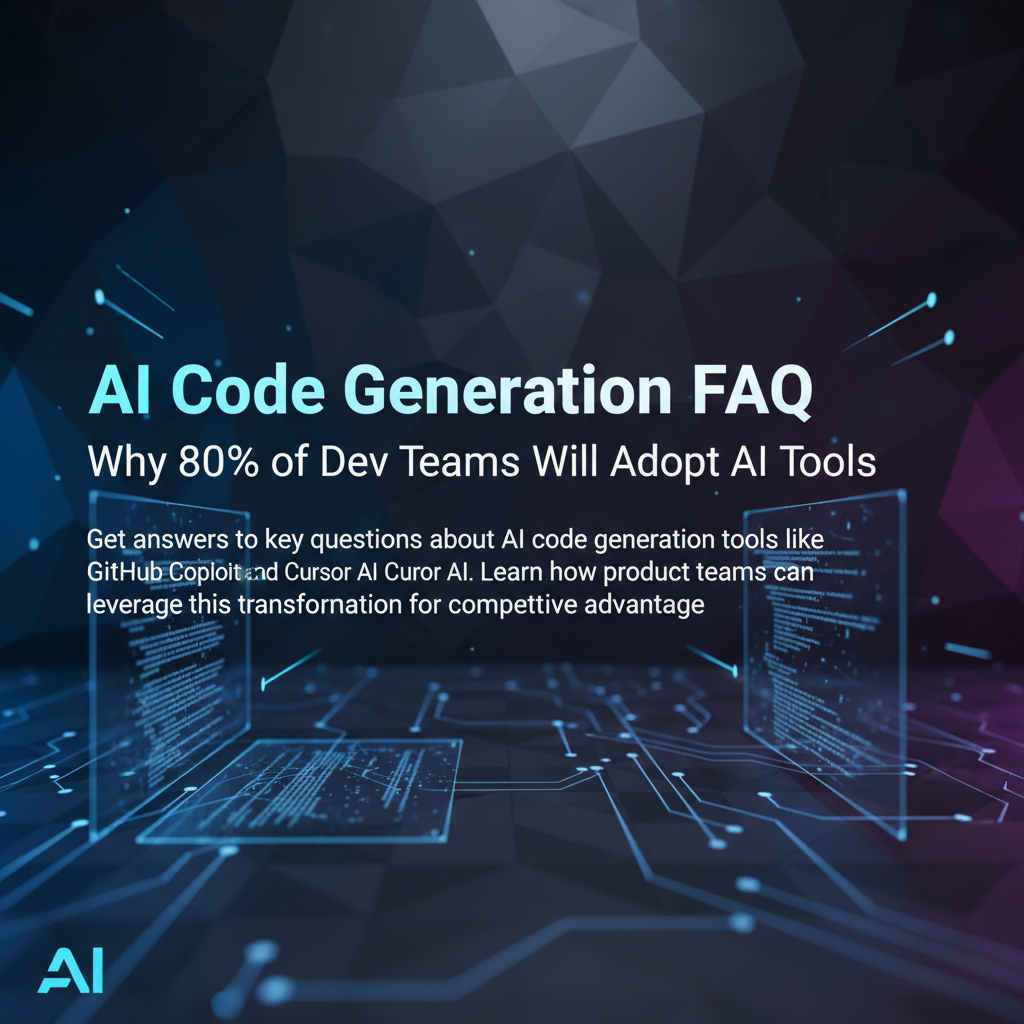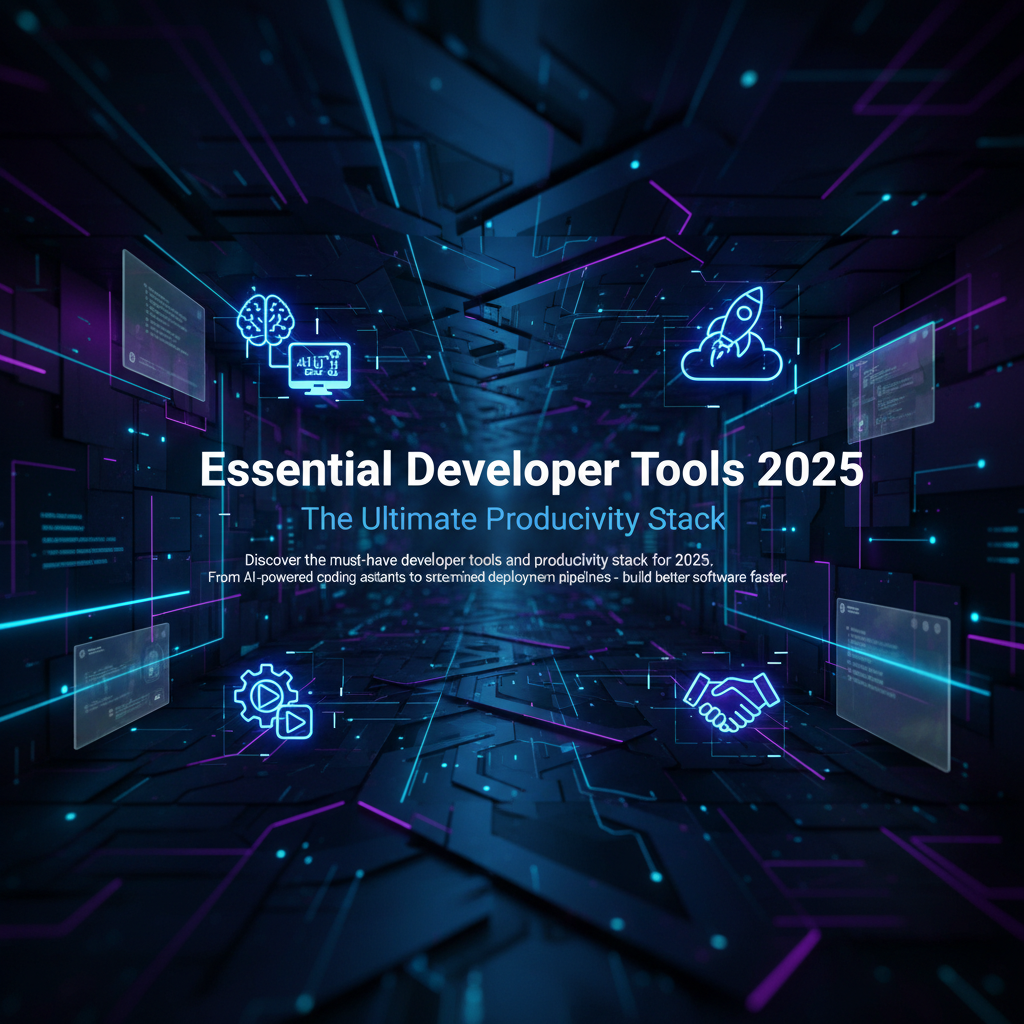Why AI Tools Fail: The Context Crisis That Broke My Code
Every developer fights AI hallucinations. I stopped fighting and started mapping system context instead. Here's how grounding AI tools in reality transforms development.
The Night AI Tools Almost Broke Everything (And What I Learned)
Every developer I know has lived this nightmare: the "small change" that detonates an entire system. Mine happened on a Thursday night in 2023 at Canva, when a seemingly innocent Slack message—"Can we add authentication to checkout?"—turned into a 12-hour debugging marathon.
On paper, it looked trivial. In practice, it broke a legacy background job that handled payment confirmations, introduced edge-case failures for mobile users in Southeast Asia, and triggered a rollback that consumed what should have been family time. But here's what really stung: my AI tools had eagerly suggested changes that looked elegant in isolation but completely ignored the hidden dependencies baked into three years of unspoken architectural decisions.
I remember staring at my Cursor suggestions at 2 AM, feeling like I was arguing with an enthusiastic intern who'd read the documentation but never lived with the consequences. The AI wasn't dumb—it was context-starved. And honestly? So was I.
That night changed everything. Instead of fighting with prompts or blaming the AI, I grabbed a whiteboard and started mapping the actual system. What began as a desperate sketch of routes → handlers → services → repositories → jobs became the foundation for a completely different relationship with AI tools for developers. Not as autocomplete toys, but as genuinely useful teammates who finally understood what they were working with.
This isn't just another story about debugging frustrations. It's about the fundamental context crisis that makes AI hallucinations inevitable—and the systematic approach that transforms AI-assisted development from guesswork into partnership.
Why Smart AI Tools Make Dumb Suggestions: The Context Problem
Here's the brutal truth about AI tools for developers: they're pattern-matching machines operating in a contextual vacuum. When GitHub Copilot suggests a function or ChatGPT recommends a refactor, it's working from statistical patterns across millions of repositories—but it has zero understanding of your system's hidden dependencies, performance constraints, or business logic quirks.
I learned this the hard way during my years at Atlassian, where we had a monolithic Django application with eight years of accumulated technical debt. The AI would confidently suggest "clean" solutions that ignored critical edge cases: the payment processor that required specific error handling for Australian tax regulations, the background job that depended on database locks in a very particular order, or the mobile API that had undocumented rate limiting.
The problem isn't that AI hallucinations in coding are inevitable—it's that we're feeding our tools incomplete information. According to recent research from Stack Overflow's 2024 Developer Survey, 76% of developers report that AI suggestions often miss crucial system context, leading to increased debugging time rather than productivity gains.
Think about how a senior engineer approaches a change request. They don't just look at the immediate code—they mentally map the blast radius. They consider data flows, error paths, integration points, and side effects. They ask: "What else touches this?" and "What breaks if this fails?" AI tools, no matter how sophisticated, can't perform this analysis without explicit context about system architecture and dependencies.
The solution isn't better prompts or more powerful models. It's giving our AI tools the same contextual foundation that experienced developers build over months of working with a codebase. When AI understands the system's actual structure—not just its surface syntax—the entire relationship changes from frustrating to genuinely collaborative.
From Whiteboard Sketch to System Intelligence: My Breakthrough Moment
At 2:47 AM, exhausted from rolling back the authentication changes for the third time, I did something that felt almost primitive: I grabbed a whiteboard marker and started drawing boxes.
Routes connected to handlers. Handlers called services. Services hit repositories. Repositories triggered jobs. Jobs sent emails and updated external systems. What started as a desperate attempt to understand why everything kept breaking became the most valuable 20 minutes I'd spent in months.
For the first time, I could see the actual blast radius of my "simple" change. The authentication middleware wasn't just validating users—it was part of a chain that affected payment processing, email notifications, mobile API responses, and even our analytics pipeline. No wonder the AI suggestions had failed so spectacularly.
"This should exist as code," I muttered to the empty office. By the next week, I had a scrappy Python script that crawled our repository, built caller/callee graphs, and extracted framework edges. It wasn't pretty, but it mapped routes, dependency injection configurations, background jobs, and database entities into a navigable structure.
The first time I ran impact_of(createCharge) and saw the complete dependency tree—including forgotten test files and deprecated job handlers—I knew I'd stumbled onto something bigger than just debugging my immediate problem.
My teammate Sarah looked over my shoulder at the output and said, "Holy shit, I had no idea the payment flow touched the recommendation engine." Neither had I. Neither had the AI. But now we all did.
That whiteboard sketch taught me that context isn't just helpful for AI tools—it's the missing foundation that separates useful assistance from expensive hallucinations. Every system has hidden knowledge, and until we make that knowledge explicit and accessible, we're essentially asking AI to navigate by guessing.
Building Context Maps That Actually Work: A Technical Deep Dive
Creating effective system context for AI tools isn't about perfect documentation—it's about building lightweight, queryable maps of how your system actually behaves. Here's the technical approach that emerged from that late-night breakthrough.
Start with automated discovery, not manual documentation. I built a script that parses your codebase and extracts structural relationships: route definitions, service dependencies, database schemas, job queues, and external API calls. The key insight is capturing edges between components, not just the components themselves. A route doesn't just exist—it calls specific handlers, which invoke particular services, which trigger certain jobs.
Capture side effects and error paths explicitly. The most dangerous missing context is what happens when things go wrong. My script evolved to identify exception handlers, retry logic, fallback mechanisms, and cleanup processes. When AI tools understand not just the happy path but also failure modes, their suggestions become dramatically more robust.
Build queryable impact analysis. The breakthrough moment came with implementing impact_of(function_name) queries that trace both upstream and downstream effects. This isn't just about "what calls this function" but "what ultimately gets affected if this function changes behavior." The difference between a risky refactor and a safe one often lies in understanding these cascading effects.
Include lightweight behavioral summaries. Pure structural analysis misses crucial context about why code works the way it does. I added simple annotations: "This service handles payments for APAC regions with specific tax logic" or "This job must complete before daily reporting runs." These human-readable summaries help AI tools understand business context, not just technical relationships.
Make it incrementally updateable. The system that works long-term is one that evolves with your codebase. Rather than massive upfront documentation, focus on capturing context as you encounter it. Each debugging session, each onboarding conversation, each architectural decision becomes an opportunity to strengthen your context map.
According to research from ThoughtWorks' Technology Radar, teams using systematic dependency mapping report 40% fewer integration bugs and 60% faster onboarding for new engineers. The investment in context pays dividends far beyond AI assistance.
See Context-Driven Development in Action: A Live Demo
Understanding context mapping conceptually is one thing—seeing it work in practice is transformative. This demonstration shows exactly how context-aware AI tools change the development experience from reactive debugging to proactive system understanding.
You'll watch the complete workflow: from running automated system discovery to querying impact analysis to getting AI suggestions that actually understand your codebase's hidden dependencies. The most powerful moment is seeing how impact_of() queries reveal unexpected connections that would have caused bugs in production.
Pay attention to how different the AI suggestions become once they have access to system context. Instead of generic patterns, you get recommendations that account for your specific business logic, error handling, and integration points. This isn't just faster development—it's safer development.
The video also covers common implementation challenges: dealing with legacy codebases, handling incomplete documentation, and building context maps incrementally without disrupting ongoing development. These practical considerations often make the difference between a proof-of-concept and a production-ready workflow.
By the end, you'll see why context-driven development feels less like fighting with AI tools and more like collaborating with a colleague who actually understands your system. The transformation from guessing to grounding changes everything about how confidently you can ship code.
From Context-Starved AI to Systematic Product Intelligence
That night of debugging taught me something fundamental about the relationship between context and intelligence—whether artificial or human. AI tools for developers fail not because they lack sophistication, but because they operate in a vacuum. Give them ground truth about your system's actual structure and behavior, and they transform from autocomplete toys into genuinely useful collaborators.
The key takeaways from building context-aware development workflows are clear: First, automated discovery beats manual documentation every time. Your system already contains the structural knowledge needed for effective AI assistance—you just need to extract and organize it. Second, side effects and error paths are where the real complexity lives. AI suggestions become dramatically more reliable when they understand not just what your code does, but what happens when it fails. Third, impact analysis queries like impact_of() turn refactoring from guesswork into informed decision-making. Fourth, incremental context building scales better than upfront documentation projects. Finally, the goal isn't perfect system maps—it's queryable intelligence that evolves with your codebase.
But here's what I've learned in the two years since that breakthrough: the context crisis extends far beyond individual codebases. The same pattern that makes AI hallucinations inevitable in development—operating without sufficient ground truth about the system you're trying to improve—plagues entire product organizations.
The Real Crisis: Vibe-Based Product Development
Most product teams today are essentially doing "vibe-based development" at scale. They're making critical decisions about what to build based on scattered feedback from sales calls, support tickets, Slack conversations, and executive hunches. Just like my AI tools that night, they're pattern-matching from incomplete information and producing elegant solutions to the wrong problems. The result? According to Pendo's 2024 Feature Usage Report, 73% of features don't meaningfully drive user adoption, and ProductPlan research shows 40% of PM time gets spent on features that never ship or get immediately deprecated.
The missing layer is systematic product intelligence—the same kind of contextual grounding that transforms AI tools from frustrating to invaluable, but applied to the entire product development process.
glue.tools: The Central Nervous System for Product Decisions
This is exactly why we built glue.tools. Think of it as the context mapping solution for product organizations—a central nervous system that transforms scattered feedback into prioritized, actionable product intelligence.
Instead of operating on vibes and assumptions, glue.tools creates systematic ground truth about what your users actually need and why. It aggregates feedback from every source—sales calls, support conversations, user interviews, feature requests, bug reports—and uses AI to automatically categorize, deduplicate, and synthesize patterns that would take weeks to identify manually. But unlike the context-starved AI tools I struggled with that night, glue.tools operates from a foundation of structured product intelligence.
Our 77-point scoring algorithm evaluates every piece of feedback across three critical dimensions: business impact (revenue potential, user satisfaction, competitive positioning), technical effort (implementation complexity, resource requirements, technical debt implications), and strategic alignment (fits company vision, supports key metrics, timing considerations). This isn't just aggregation—it's intelligent prioritization that thinks like a seasoned product strategist.
The 11-Stage AI Analysis Pipeline
What makes glue.tools transformative is our systematic approach to converting feedback into specifications. Our 11-stage AI pipeline doesn't just collect insights—it processes them through the same kind of rigorous analysis that senior product managers perform: market analysis → user segmentation → jobs-to-be-done identification → use case prioritization → user story generation → acceptance criteria definition → technical requirements → integration planning → success metrics → risk assessment → implementation roadmap.
The output isn't just another dashboard of metrics. You get complete PRDs with user personas, detailed user stories with acceptance criteria, technical blueprints that developers can actually implement, and interactive prototypes that stakeholders can experience before writing any code. We compress what typically takes product teams 3-4 weeks of requirements work into approximately 45 minutes of AI-powered analysis.
Forward and Reverse Mode Intelligence
Just like my system mapping tools that could trace both upstream and downstream effects, glue.tools operates in two powerful modes:
Forward Mode transforms strategic vision into concrete specifications: Strategy → personas → JTBD → use cases → stories → schema → screens → prototype. This is where most product intelligence tools stop, but it's only half the solution.
Reverse Mode analyzes your existing codebase and product analytics to reconstruct the system's current behavior: Code & tickets → API & schema map → story reconstruction → tech-debt register → impact analysis. This creates the same kind of ground truth context that transformed my relationship with AI development tools.
The continuous feedback loop between these modes means that changes in user feedback automatically propagate into concrete edits across your specifications, user stories, and even HTML prototypes. No more wondering whether your roadmap reflects current reality.
Business Impact: From Reactive to Strategic
Teams using glue.tools report an average 300% improvement in ROI from product development efforts. The reason isn't just efficiency—it's accuracy. When you stop building based on assumptions and start building from systematic product intelligence, you naturally focus on features that actually drive user adoption and business outcomes.
Think of glue.tools as "Cursor for PMs"—the same kind of transformative productivity boost that AI coding assistants provided for developers, but applied to the entire product development process. Just as context-aware AI tools make developers 10× more effective at writing code, systematic product intelligence makes product managers 10× more effective at defining the right things to build.
We're already trusted by hundreds of companies and product teams worldwide who've experienced the transformation from reactive feature building to strategic product intelligence. The early results validate what I learned that night debugging authentication: intelligence without context is just expensive guessing, but intelligence grounded in systematic understanding changes everything.
Ready to stop guessing and start grounding your product decisions in reality? Experience the systematic approach that transforms product development from vibe-based building to intelligence-driven delivery. Your first PRD generated through our 11-stage pipeline will show you exactly what systematic product intelligence feels like—and why scattered feedback finally makes sense when processed through the right context.
Frequently Asked Questions
Q: What is why ai tools fail: the context crisis that broke my code? A: Every developer fights AI hallucinations. I stopped fighting and started mapping system context instead. Here's how grounding AI tools in reality transforms development.
Q: Who should read this guide? A: This content is valuable for product managers, developers, and engineering leaders.
Q: What are the main benefits? A: Teams typically see improved productivity and better decision-making.
Q: How long does implementation take? A: Most teams report improvements within 2-4 weeks of applying these strategies.
Q: Are there prerequisites? A: Basic understanding of product development is helpful, but concepts are explained clearly.
Q: Does this scale to different team sizes? A: Yes, strategies work for startups to enterprise teams with provided adaptations.



